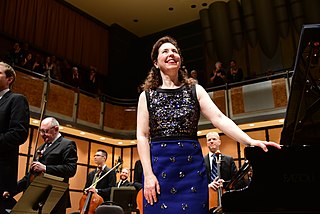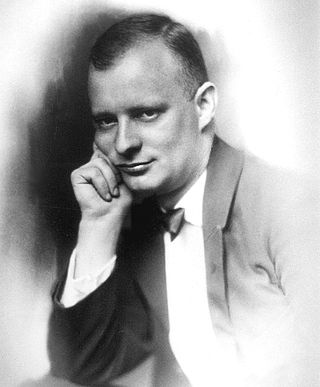Related Research Articles

Ludwig van Beethoven's Opus 1 is a set of three piano trios, first performed in 1795 in the house of Prince Lichnowsky, to whom they are dedicated. The trios were published in 1795.

Isaac Stern was an American violinist.

Sonata, in music, literally means a piece played as opposed to a cantata, a piece sung. The term evolved through the history of music, designating a variety of forms until the Classical era, when it took on increasing importance. Sonata is a vague term, with varying meanings depending on the context and time period. By the early 19th century, it came to represent a principle of composing large-scale works. It was applied to most instrumental genres and regarded—alongside the fugue—as one of two fundamental methods of organizing, interpreting and analyzing concert music. Though the musical style of sonatas has changed since the Classical era, most 20th- and 21st-century sonatas still maintain the same structure.

Ludwig van Beethoven's Piano Sonata No. 7 in D major, Op. 10, No. 3, was dedicated to the Countess Anne Margarete von Browne, and written in 1798. This makes it contemporary with his three Op. 9 string trios, his three Op. 12 violin sonatas, and the violin and orchestra romance that became his Op. 50 when later published. The year also saw the premiere of a revised version of his second piano concerto, whose original form had been written and heard in 1795.
The viola sonata is a sonata for viola, sometimes with other instruments, usually piano. The earliest viola sonatas are difficult to date for a number of reasons:

Ludus Tonalis, subtitled Kontrapunktische, tonale, und Klaviertechnische Übungen, is a piano work by Paul Hindemith that was composed in 1942 during his stay in the United States. It was first performed in 1943 in Chicago by Willard MacGregor. The piece explores "matters of technique, theory, inspiration, and communication. It is in effect, a veritable catalogue of the composer's mature style."

Angela Hewitt, is a Canadian classical pianist. She is best known for her Bach interpretations.

Franz Theodor Reizenstein was a German-born British composer and concert pianist. He left Germany for sanctuary in Britain in 1934 and went on to have his teaching and performing career there. As a composer, he successfully blended the equally strong but very different influences of his primary teachers, Hindemith and Vaughan Williams.
Arnold Atkinson Cooke was a British composer.
Georgy Lvovich Catoire was a Russian composer of French heritage.

Edwin York Bowen was an English composer and pianist. Bowen's musical career spanned more than fifty years during which time he wrote over 160 works. As well as being a pianist and composer, Bowen was a talented conductor, organist, violist and horn player. Despite achieving considerable success during his lifetime, many of the composer's works remained unpublished and unperformed until after his death in 1961. Bowen's compositional style is widely considered as ‘Romantic’ and his works are often characterized by their rich harmonic language.
The Cello Sonata in G minor, Op. 65, was written by Frédéric Chopin in 1846-1847. It is one of only nine works of Chopin published during his lifetime that were written for instruments other than piano. Chopin composed four sonatas, the other three being piano sonatas. The cello sonata was the last of Chopin's works to be published in his lifetime.
The ‘’'Violin Sonata’'’ No. 4 in A major, Op. posth. 162, D 574, for violin and piano by Franz Schubert was composed in 1817. This sonata, composed one year after his first three sonatas for the same instruments, was a much more individual work, showing neither the influence of Mozart, as in these previous works, nor of Rossini, as in the contemporaneous 6th Symphony.

Lawrence Power is a British violist, born 1977, noted both for solo performances and for chamber music with the Nash Ensemble and Leopold String Trio.

The first Sonata for viola and piano, also known as Sonata in F, Op. 11, No. 4, by Paul Hindemith was composed in 1919. It is the fourth of five instrumental sonatas comprising his opus 11. This sonata and the following Op. 11 No. 5 for solo viola mark Hindemith's decision to abandon playing the violin in favor of its larger cousin.

Tanja Becker-Bender is a German violinist. She lives in Berlin and Hamburg.
Violin Sonata No. 24 in F major, K. 376, was composed by Wolfgang Amadeus Mozart in Vienna during the summer of 1781. Like all other sonatas of Op. 2, this piece also has three movements.

The Violin Sonata No. 2 for piano and violin, in D major, Op. 11, No. 2, is the second surviving violin sonata for the two instruments by Paul Hindemith, composed in 1918. It was published as Sonate in D für Klavier und Violine.
Markus Becker is a German pianist and academic teacher. He is focused on chamber music, and on piano concertos from the time around 1900. His recording of the complete piano works by Max Reger earned him awards. He is also a jazz pianist, and has been professor of piano and chamber music at the Hochschule für Musik, Theater und Medien Hannover since 1993.
References
- ↑ "Piano Sonata No. 2 in G major – Details – AllMusic". AllMusic.
- ↑ "Piano Sonata No 2 in G major (Hindemith) – from CDA67977 – Hyperion Records – MP3 and Lossless downloads". www.hyperion-records.co.uk.